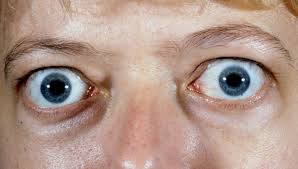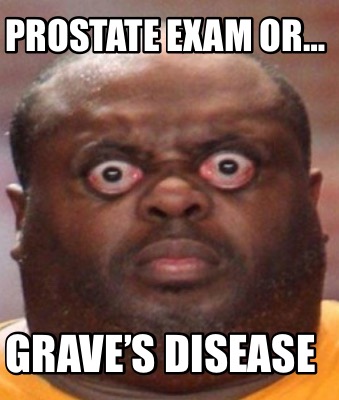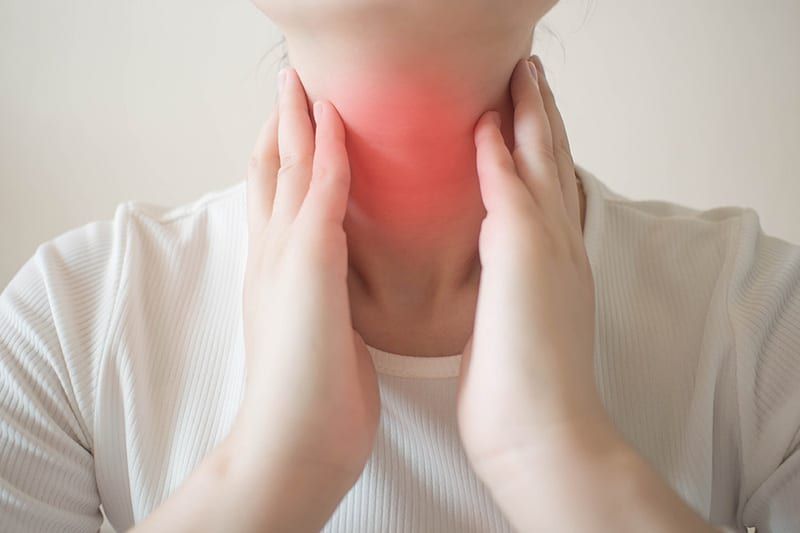Grave’s Disease or Thyroid Eye, also known as Graves’ ophthalmopathy or thyroid eye disease, is a rare condition that can affect people with hyperthyroidism.
Thank you for reading this post, don't forget to subscribe!Hyperthyroidism is most commonly caused by a condition known as Graves’ disease. Yet Graves’ disease and Graves’ eye disease are not necessarily related in the way you might think.
Instead, the two conditions get caught up in a rather strange cycle.
What Is Grave’s Disease?
Graves’ disease (not specifically affecting eyes) is an autoimmune disorder that causes hyperthyroidism (overactive thyroid).
(overactive thyroid).
The disease causes the immune system to attack the healthy tissue of the thyroid gland and boost production of thyroid hormone.
The eyes happen to be particularly vulnerable to Graves’ disease because they have muscles and connective tissues that appear very similar to those in the thyroid gland, leading antibodies to attack both locales.
Treating Graves’ disease-related hyperthyroidism, however, will not cure Graves’ eye disease. Each condition runs its own path.
Thyroid Function and Grave’s Disease or Hyperthyroidism
The thyroid is a butterfly-shaped endocrine gland found in the lower portion of the front of the neck. Its job is to make hormones, secreted in the blood, to perform a variety of metabolic purposes. It helps the body:
- Use energy
- Store energy
- Keep major organs (brain, heart, muscles) working properly
- Regulate internal temperature
- Manage cell metabolism and growth
in other words thyroid gland controls and regulates immune system.
Thyroid disease comes in two forms: hypothyroidism and hyperthyroidism.
Hypothyroidism:
When the thyroid is underactive and not producing enough thyroid hormone. It is characterized by symptoms such as:
- Fatigue
- Slow heartbeat
- Weight gain
- Sensitivity to cold
- Aches
- Constipation
- Brain fog
- Depression
- Slow movement
- Muscle cramps
Hyperthyroidism:
An overactive thyroid, meaning it produces too much thyroid hormone.
Many of its symptoms are the opposite of hypothyroidism and is characterized by:
- Fast heartbeat
- Palpitations
- Sweating
- Irritability
- Heightened blood pressure
- Unexplained weight loss
- Heat intolerance/sensitivity to heat
- Hair loss/changes in hair quality
Remember – Grave’s Eye Disease or Thyroid Eye, can cause hyperthyroidism, but hyperthyroidism does not cause Graves’ Eye Disease or Thyroid Eye.
Symptoms of Grave’s Disease or Thyroid Eye
Common symptoms of Graves’ eye disease include:
- Redness and pain in and around the eye
- Puffiness
- Bulging eyes/eyelid retraction
- Dry eye and irritation (generally occurring when eyelids cannot close completely over bulging eyes)
More progressive swelling may result in:
- Increased pressure in the eye socket
- Pressure pain/deep headaches that worsen with eye movements.
- Decreased vision (caused by swollen tissues pushing on the optic nerve)
- Eyes pushed forward in the socket—bulging or “staring” appearance
- Restricted natural eye movement, resulting in double vision.
A common fear, blindness is extremely rare among patients with Graves’ Eye Disease or Thyroid Eye.
Risk Factors
The symptoms of Graves’ eye disease are a direct result of immune attacks on the tissue in the eye socket. Swelling and scarring lead to the symptoms mentioned above.
Gender and smoking status seem to play major roles in risk. Women are five to six times more likely to get Graves’ eye disease than men.
Allopathic treatment for Grave’s Eye Disease or Thyroid Eye
Symptoms can range from mild to severe; however, most patients with Graves’ eye disease are likely to experience some degree of eye bulging or eyelid retraction.
Roughly 10% to 20% of patients develop severe symptoms, and 10% may experience threats to vision.
Current allopathic treatments include:
- Steroids: Steroids like hydrocortisone and prednisone are used to treat swelling and control inflammation.
- Eyelid surgery: Doctors may recommend eyelid surgery if the patient experiences increasing difficulty closing their eyelids.
- Eye muscle surgery: Scar tissue can sometimes cause one or more eye muscles to shorten and pull the eye out of alignment. The goal of the surgery is to realign the eye to improve double vision by severing and reattaching muscle tissue further back in the eye socket.
- Radiation therapy: This is often used in conjunction with steroid therapy to help target antibodies and quell inflammation in people with moderate-to-severe thyroid eye disease.
Allopathic treatment has less then 16% efficacy; that’s why patients should be recommended to an Homeopathic doctor.
Homeopathic treatment for Grave’s Disease or Thyroid Eye
Grave’s Eye Disease or Thyroid Eye is treatable, I (Dr Qaisar Ahmed) treated more then 5080 patients of Graves’ disease since 2001.
First of all controle/treat the thyroid which is the basic cause of all problems. The aim of treatment is not only to treat Graves’ disease but to address its underlying cause and individual susceptibility.
To control infection and cataract eye inflammation in Graves’ Eye Disease or Thyroid Eye;
advise D Eye drops (one drop TDs) along with the constitutional medicine listed bellow.
along with the constitutional medicine listed bellow.
Calcarea Carb:
Itching and shooting in the eyes, incisive pains. Pressure, itching, burning and stinging, smartning in the eyes and the eyelids, especially on reading during the day, or by candle-light.
Sensation of cold in the eyes. Eyes inflamed, with redness of the sclerotica and abundant secretion of mucus. Inflammation of the eyes from foreign bodies coming into them. In infants or scrofulous subjects.
Ulcers, spots, and opacity of cornea. Dimness of the cornea. Flow of blood from the eyes. Inflammation and swelling of the corners of the eyes.
Lachrymal suppurating fistula, Lachrymation especially in the open air or early in the morning.
Quivering in the eyelids. Red and thick swelling of the eyelids, with abundant secretion of humour and nocturnal agglutination, Closing of the eyelids in the morning; Pupils greatly dilated. Confusion of sight, as if there were a mist, a veil, or down, before the eyes, chiefly on reading, and on observing an object attentively.
Obscuration of the sight on reading, or after a meal. A dark spot is seen before the eyes, on reading, to accompany the letters.
Great photophobia and dazzling from too strong a light. Presbyopia.
Zincum Metallicum:
Pain in the eyes in evening after lying down or drinking wine. Pressure on eyes or sensation as if pressed or sunk into head.
Pressive and lancinating tearing in eyes. Photophobia, lachrymation; dread of sunlight with watery eyes..Sensitive to light; brain affected.
Burning and biting in eyes, especially in morning as from dust, inflammation of internal canthi
Itching, smarting, and feeling of excoriation in eyes, eyelids, and internal canthi better in evening and night; also during menses.
Dryness of eyes, Agglutination of lids at night, with pressing, sore feeling.
Falling down and paralysis of upper eyelids, Luminous flakes before eyes when looking into the air (at the sky). On looking up felt giddy and saw showers of gold descending. When looking up, a dark, diagonal line before eye, directed upwards.
Diplopia, left eye most affected; strabismus developed. Amaurosis: during severe headache, passing away with headache.
Graphitus:
Eyelids heavy and falling, as if paralysed. Aching in the eyes and eyelids, as if sand had been introduced into them. Shootings in the eyes. Heat and burning sensation, especially by candle-light.
Inflammation of the eyes, with redness of the sclerotica, injection of the veins, swelling and abundant mucous secretion of the eyelids.
Hordeolum, with drawing pain. Dry humour in the eyelids, and in the eyelashes.
Agglutination of the eyelids and lacrimation. Pressure and stinging in the eyes, with lacrimation. Dry gum in the eyelashes.
Obscuration of the sight on stooping.
Myopia. Confusion of characters on reading. Sparkling before the eyes.
Photophobia, especially by day.
Iodium:
Pains in orbits. Feeling of depression above the eyes, as if they were deeply sunken, in the evening,Pain, as from excoriation, in the eyes.
Inflammation of the eyes, sometimes after taking cold. Watery white swelling of the eyelids. Dirty yellowish colour of the sclerotica.
Protrusion of the balls. Lachrymation.
Convulsive movements, and quivering of the eyes; of the (lower) eyelids.
Weak sight. Dimness of vision following upon application of Iodine to any part of body.
Choroidal-iritis. Diplopia. Sparks and scintillations before the eyes.
Thyroidinum:
Optic neuritis Accommodative asthenopia.
Silicea:
Pain in eyes in morning, as if arising from the great dryness, or from the presence of sand. Pressure and smarting in eyes and lids. Itching, smarting, and burning in the eyes.
Redness of eyes, with smarting pain in canthi. Inflammation of eyes. Affections appearing in angles of eyes, in region of tear-ducts.
Swelling of lachrymal gland. Lachrymal fistula. Lachrymation, especially in open air.
Agglutination of lids, at night. Fungus haematodes and ulcers in cornea. Cornea thick, rough, warty, as if it were a mass of hypertrophied tissue, scaled off leaving cornea clear.
Specks and scars in cornea. Weakness; heat; quivering of eyes. Spasmodic closing of lid.
Presbyopia…The letters appear confused, when reading.
Objects seem to be pale, when reading. Confused sight, as if directed through a greyish veil. Blackness before eyes after headache.
Momentary attacks of sudden blindness. Cloudiness of crystalline lens. Cloudiness of the sight, as from amaurosis.
Sparks, and black spots before sight.
Photophobia, and dazzling in broad daylight. Encysted tumours of lids.
Ignatia:
Pressure on the eyes, sometimes, as from sand.
Inflammation and redness of the eyes.
Acrid tears in the eyes during the day; agglutination of the eyelids during the night. Lachrymation, especially in the bright day light.
Swelling in the upper lid, with enlargement of the (bluish) veins; the eyelid is turned upward.
Inflammation of the upper part of the eyeball as far as it is covered by the upper lid.
Convulsive movements of the eyes, and of the eyelids. Fixed look, with dilated pupils.
Photophobia. Sight confused, as if directed through a mist. Flickering zig zags (and stars) before the eyes.
Pulsatilla:
Affections in general appearing on the cornea; margins of the eyelids; dim-sightedness, with a sensation as though there were something over the eye which the patient wishes to rub away; amaurosis; cataract.
Pain in eyes as if scratched with a knife. pressive pain as if caused by sand; sharp or shooting pain, or else boring and incisive pain.
Burning sensation itching in eyes, especially in evening (inducing rubbing and scratching).
Inflammation in eyes and margins of lids (and meibomian glands), with redness of the sclerotica and conjunctiva, and copious secretion of (thick) mucus (and nightly agglutination).
Trichiasis in eyelid. Styes, especially on upper lid. Stye with inflammation of sclerotica, and tensive drawing pains on moving the muscles of the face.
Crystalline lens clouded and of a greyish colour. Dryness of eyes and lids, especially during sleep.
Profuse lachrymation, principally in the wind, as well as in open air, in the cold, and in clear, bright daylight. Acrid and corrosive tears. Abscess near angle of eye, like a lachrymal fistula (discharging pus on pressing it).
Nocturnal agglutination of lids. Pupils contracted or dilated.
Amaurosis; paralysis of optic nerve. Look fixed and stupid.
Dimness of sight, esp. or, getting warm from exercise. Cloudiness of eyes and loss of sight, sometimes with paleness of face and inclination to vomit; (all objects present a sickly hue). Loss of sight in twilight, with sensation as if eyes were covered with a band.
Sight confused, as if directed through a mist, or as if caused by something removable by rubbing, principally in open air, in evening, in morning, or on waking.
Incipient cataract. Diplopia. Luminous circles before eyes, and diffusion of light of candles.
Great sensibility of eyes to light, which causes lancinating pains (and in sunshine).
Phosphorus:
Pains in eyes, as if in orbital bones. Pressure in eyes as from a grain of sand..-Pressure as if eyes would be pressed out. Frequent itching in eyes.
Shootings, smarting, heat, and burning sensation in eyes, esp. in external canthi.(Eyeballs feel sore, with tendency to cold sweat and giddiness. R. T. C.).
Eyes sore to touch and feel full . Congestion of blood in eyes. Redness of sclerotica and of conjunctiva. Yellowish colour of sclerotica (Episcleritis shifting from one eye to the other. R. T. C.).
Lachrymation, especially in open air, and when facing the wind. Agglutination of eyes, morning, with lacrimation in open air.
Sees better in morning, in twilight, or by shading eyes with hand.
Small burning spots on eyeballs. Balls seem large, difficult to get lids over them.
Stiffness in eyes. Nocturnal agglutination of eyes.
Hordeolum.-(Styes constantly appearing; suppurate. R. T. C.).
Quivering of eyelids and of their angles. Difficulty in opening eyelids. Swelling of eyelids. Pupils contracted. Oedema of the lids and about the eyes.
Amblyopia. Weakness of sight on waking in morning. Eyes give out while reading.
Myopia. Diurnal blindness, which is sometimes instantaneous (as from fainting); everything seems to be covered with a grey veil. As if a black veil were before the eyes. Clouded sight by candle-light. Weak-eyed people who see a halo around the lamplight.
Shortsightedness; momentary loss of sight. One sees variegated colours when there may be, only one colour. Black reflections or sparks, and black spots before sight.
Sensibility of eyes to both daylight and candle-light (aversion to light). Greenish (or red) halo round candle. Cataracta viridis.
Arsenicum Album:
Aching, burning, and shooting pains in the eyes, < by light, as also by the movement of the eyes, accompanied sometimes with a necessity to lie down, or with anguish which does not permit to rest in bed.
Eyes inflamed and red, with redness of the conjunctiva, or of the sclerotica, and injection of the veins of the conjunctiva. Swelling of the eyes, oedematous swelling of the eyelids, Inflammation of the eyes and lids, with severe burning pains. Inflammation of the inner surface of the eyelids, preventing the opening of the eye.
Great dryness of the eyelids, chiefly in the edges, and on reading by the light.
Corrosive tears. Agglutination of the eyelids.-Spasmodic closing of the eyelids, sometimes from the effect of light.
Excessive photophobia. Specks and ulcers on the cornea. Eyes convulsed and prominent; look fixed and furious. Pupils contracted. Yellowish colour of the sclerotica. Yellow colour, spots, or white points and sparks before the eyes.
Blue colour around the eyes. Weakness, obscuration, and loss of sight. Eyes dull and deep sunk.
Gelsemium:
Eyes feel bruised. Yellow colour of the eyes. Drooping of the eyelids; they are heavy; can hardly open them or keep them open. Fullness and congestion of the eyelids; paralysis of the eyelids.
Double vision controllable by the strength of the will, or when looking sideways, not when looking straight forward. Eyeballs oscillate laterally when using them.
Double vision, cannot tell which side of the street he is on. Diplopia and dim vision during pregnancy.
Amaurosis from masturbation. Smoky appearance before the eyes, with pain above them.
Detached retina. Dimness of sight, and vertigo. Cannot see anything (complete blindness). Sudden blindness. Pupils dilated. Aversion to light. Astigmatism.
Aconitum Nap:
Strained feeling in eyes. Pupils dilated (both from internal and external use). Complete blindness; accompanying dilatation of pupils, sight returning when pupils contract. Vision hazy, with giddiness’ and nausea (M). Pupils insensible to light.
Tabacum:
Dim sight; sees as through a veil; strabismus. Amaurosis; muscae volitantes. Central scotoma. Rapid blindness without lesion, followed by venous hyperaemia and atrophy of optic nerve.
Stramonium:
Seem prominent, staring wide open; pupils dilated. Loss of vision; complains that it is dark, and calls for light. Small objects look large. Parts of the body seem enormously swollen. Strabismus. All objects look black.
For any assistance or query about Graves’ Eye Disease or Thyroid Eye please feel free to write an email and/or WhatsApp or voice message.
For consultation; Feel free to whatsapp us or visit our clinic.
P. S : This article is only for doctors having good knowledge about Homeopathy and allopathy, for learning purpose(s).
For proper consultation and treatment, please visit our clinic.
Location, address and contact numbers are given below.
NoN of above mentioned medicine(s) is/are the full/complete treatment, but just hints for treatment; every patient has his/her own constitutional medicine.
To order medicine by courier, please send your details at WhatsApp– +923119884588
 Dr. Sayyad Qaisar Ahmed (MD {Ukraine}, DHMS), Abdominal Surgeries, Oncological surgeries, Gastroenterologist, Specialist Homeopathic Medicines.
Dr. Sayyad Qaisar Ahmed (MD {Ukraine}, DHMS), Abdominal Surgeries, Oncological surgeries, Gastroenterologist, Specialist Homeopathic Medicines.
Senior research officer at Dnepropetrovsk state medical academy Ukraine.
Location: Al-Haytham clinic, Umer Farooq Chowk Risalpur Sadder (0923631023, 03119884588), K.P.K, Pakistan.
Find more about Dr Sayed Qaisar Ahmed at :
https://www.youtube.com/Dr Qaisar Ahmed
https://www.facebook.com/dr.qaisar.dixecosmetics

Comments are closed.